I’ve written so many articles on cleaning the bathroom because everyone has a bathroom, cleaning the bathroom can be a big job, and there are a lot of components that need to be dealt with and cleaned in the bathroom. If you’re looking for general bathroom cleaning tips, check out The Ultimate Bathroom Cleaning Checklist, How to Clean a Bathroom: Cleaning Hacks, and 10 Things to Clean in the Bathroom Besides the Obvious.
Something I haven’t covered yet is how to clean bathroom tiles. Cleaning bathroom tiles is a big job because they can collect soap scum and because mildew and mold in the bathroom can build up on tiles. Plus you have to know how to clean bathroom grout. It’s not hard to clean bathroom tiles, but it is important to know what you’re doing so you can really use your time efficiently and eliminate soap scum and bathroom mildew.
But the biggest barrier to cleaning bathroom tiles correctly is knowing what type of tile you have in your bathroom and the correct products and tools to use with your particular type of tile. Sometimes people just throw whatever cleaning product and tool at their bathroom tile and hope for the best. But you can actually damage your tile if you use the wrong products and tools. So today we’re going over types of bathroom tiles and how to clean them.
An acidic product can stain your natural stone and essentially ruin your tile. And these tiles can be easily scratched, so be sure to use a soft tool to clean them. Basically, stick to a very PH neutral cleaner and a gentle tool when it comes to natural stone.
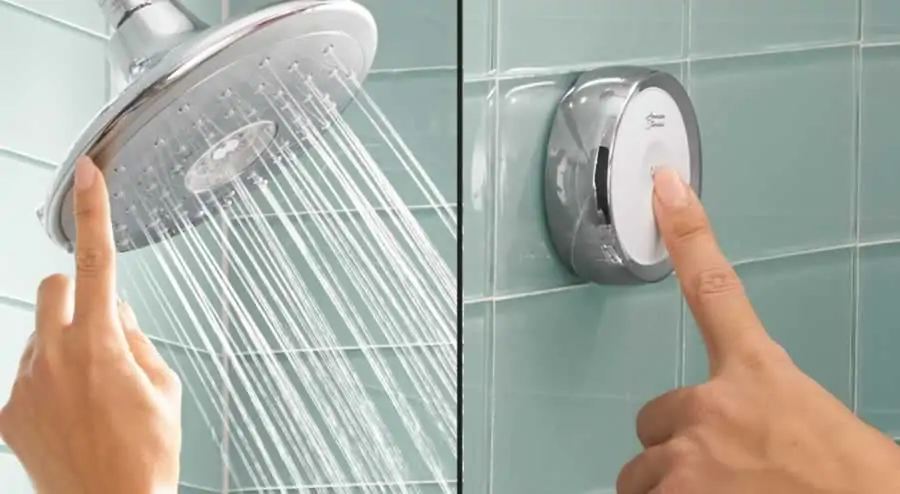
Types of Bathroom Tiles
A big problem people encounter when cleaning bathroom tiles is not knowing how to clean their particular type of tile. The first type of tile that we most often see in a bathroom is a ceramic or a porcelain tile. This is what I have. It’s very durable and very easy to clean, so if you have ceramic tiles, congratulations! You’ve won the bathroom tile lottery.
Ceramic and porcelain tiles can’t really be damaged with product so you can use most tile cleaners. However, you do want to make sure that you’re using a non-scratching tool because you don’t want to ruin the finish.
Cement tiles are another popular material for bathroom tiles. A word of warning, cement tiles do not like acidic cleaners! Acidic cleaners can wear away at the sealer and damage the surface of cement tiles. And be sure to use a nonabrasive tool when cleaning.
Next up are glass tiles. Now, these are moisture resistant as well as stain resistant so they’re a good choice for the shower. However, you have to make sure when it comes to cleaning you’re not using anything abrasive. That goes for both products and tools, because glass is easily scratched.
Finally, there’s the big old umbrella category of natural stone. I’m talking granite, marble, limestone, slate, quartz, and travertine. Natural stone tiles in the bathroom can be a high polished finish or a more raw unpolished finish. Both options look really beautiful, but you have to be really careful when it comes to cleaning them.
That’s all you’ve ever wanted to know about types of bathroom tiles (and I would guess more than you ever wanted to know) so let’s move onto the bain of my existence when it comes to cleaning the bathroom.
Soap Scum on Bathroom Tiles
Soap scum buildup is a big complaint when it comes to cleaning the bathroom. It can build up quite quickly, meaning you have to clean more often than you’d like. Let’s talk about what soap scum is, and how to prevent soap scum buildup.
Soap scum is a combination of hard water that comes out of your shower head combined with dead skin cells, body oils, and any products you use in the shower. It’s pretty gross when you think about it… and now I’m thinking about it. Ew!
Anyway, every time you finish showering, the water droplets dry on your shower tile and anything that is contained in those water droplets sticks to the tiles. Over time that builds up, causing soap scum.
Soap scum is impossible to avoid completely, but using the right products and tools when you clean will eliminate it… until the next time you shower. And I’ll let you in on a little secret, you can use a daily shower cleaner to prevent soap scum buildup! I’ve got the recipe for you in my DIY Daily Shower Cleaner article!

Mildew and Mold in the Bathroom
Another common issue people run into when it comes to bathroom cleaning is mold and mildew. The bathroom is a moist place (sorry to everyone who hates the word moist). Dampness combined with poor ventilation equals mold and mildew. In the bathroom, particularly in the shower, there’s going to be an ongoing battle between you getting clean and you preventing mold and mildew from building up in there.
The easiest way to stay on top of moisture is to have every member of the household squeegee the shower walls after every shower to eliminate moisture buildup. This will also help prevent soap scum buildup too! No idea what I’m talking about? Read How to Clean a Bathtub and Shower Like a Pro.
To stop mold and mildew from occurring, use my DIY daily shower cleaner. The ingredients work to kill bacteria before it has a chance to turn into mold. However, if you do notice mold and mildew you can make a solution with equal parts bleach and water to try and tackle it. Or, pick up a store-bought product.
Finally, make sure you ventilate your bathroom so it doesn’t feel like a tropical destination. You should be running your bathroom fan for at least 30 minutes after every shower. If you don’t have a bathroom fan, absolutely open a window and leave it open for at least 30 minutes.
How to Clean Bathroom Tiles: Ceramic and Porcelain
When it comes to cleaning ceramic or porcelain tiles, these are the most durable, and they can handle just about any product that’s appropriate for tub and tile cleaning, whether it’s something that you make or something that you buy.
I prefer to make my own cleaning products when possible, and making your own tile cleaner is super easy if you have ceramic or porcelain tile. However, if you have quite a lot of soap scum and buildup, like in a shower that hasn’t been cleaned for a while, I would recommend choosing a store-bought option.
To make your own tile cleaner, simply add a half cup of dish soap and a half cup of white vinegar to a spray bottle. Then you can customize the scent with five drops of essential oil, but no need to do this if you don’t have or don’t like essential oils. (If you do like essential oils, read Everything You Need to Know About Cleaning with Essential Oils.
To clean ceramic and porcelain tile, spray your cleaning product on the tile and let it sit for five to 10 minutes. You don’t want the cleaner to dry; you just want it to have time to do its work. After that time has passed, go in there with a non-scratch scrub pad and use the “S” pattern to clean from top to bottom.
If you have high tiles like I do, you can actually use a mop. I use the Maker’s Clean Mop for this because the mop pad is already microfiber, so it’s the perfect tool to save my arms and shoulders from doing more work than they need to.
You should see (or feel) soap scum start to come off. The tiles will feel smoother, and they won’t have that gritty feeling from soap scum. When you’re finished, rinse everything down and buff it dry with a microfiber cloth.
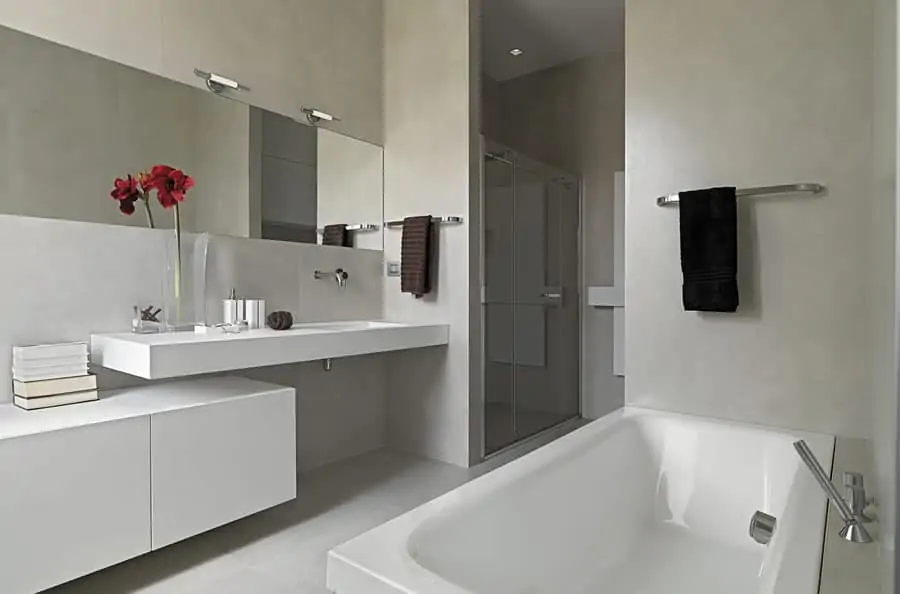
How to Clean Bathroom Tiles: Cement, Glass, and Natural Stone
I’m going to treat cement, glass, and natural stone tiles with the same type of product and tool recommendations because they’re much more delicate than your ceramic and porcelain tiles.
As I said, you want to stay away from anything that’s acidic and anything that’s abrasive. If you have a steam cleaner, that’s actually the perfect thing to use for cleaning these kinds of delicate tiles. For glass tiles, I like to use Rejuvenate Scrub Free Soap Scum Remover, and for stone, I recommend StoneTech Revitalizer Cleaner.
To use these cleaners or another appropriate cleaner for your tile, it’s important to follow the package instructions. But essentially, you’re going to spray the cleaner on your tiles, let it sit for approximately 10 minutes, and use a non-abrasive scrub pad to scrub. And don’t forget to rinse!
How to Clean Shower Floors
When it comes to cleaning shower floors, here’s a tip. Use a deck brush. These are easy to find online and in stores. You can either dilute your cleaning product in a bucket with water or squirt your product on the floor and agitate it with the deck brush. This is great for everyone, but especially for anyone with mobility issues who might find getting on their hands and knees difficult.
When cleaning your shower, always start with the tiles first and then move on to the floors. That way, you avoid having to reclean the floors when soap scum and product fall down from your shower walls. And keep the floors as dry as possible, so you don’t slip.
How to Clean Bathroom Grout
Now, the thing that holds it all together: grout. Grout is the binder that holds your tiles in place and also prevents moisture from getting in between them. But ironically, grout is actually porous. So every time you shower, it absorbs a little bit of the water, body oil, soap scum, you get the picture.
The only difference between your tile and your grout is that it’s really difficult to penetrate the grout and get all the dirt out. That’s why you need a special grout cleaning product. Lucky for you, I have a great DIY recipe for that!
Mix one part hydrogen peroxide to two parts baking soda until it forms a paste. Then, apply the paste to your grout with a cleaning toothbrush and let it sit for about 10 minutes. When the time is up, use your cleaning toothbrush to give your grout a thorough scrub. Rinse and buff dry.
If you have a really stained tile, you can mix up a solution of oxygen bleach and use that instead of my DIY paste. And if you often have very stained tile, or you notice your grout gets dirty quickly, I would consider applying a grout sealant.
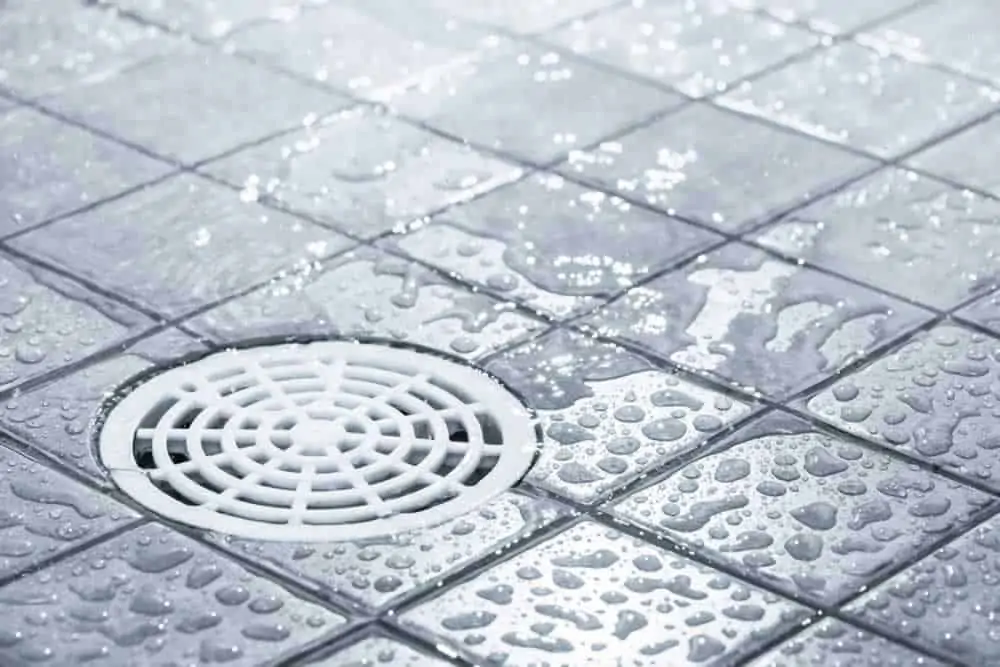
How to Clean Bathroom Tiles
I would bet money that you now know more about bathroom tiles from this article than most people learn in a lifetime! And while this might not be the information you have always dreamed of learning, it will sure help you when it comes to cleaning (and not damaging) your bathroom tile.
I included a lot of DIY recipes in this article, and I have so many more! Check out my bestselling printable, 50 DIY Cleaning Recipes, for my entire collection of amazing cleaning recipes you can make at home for much cheaper than store-bought products. And let me know in the comments below what kind of bathroom tile you have and if you are using my tips to clean it!
Looking for a BETTER & EASIER Way to Clean Your Home?
Cleaning Expert Melissa Maker is here to help with her game-changing 3 Wave Cleaning System that will help you clean your house faster and easier than you ever thought possible!







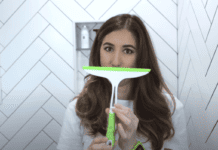








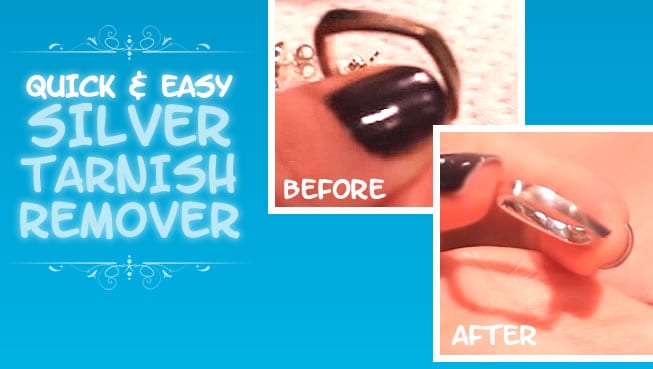


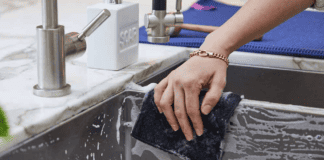
[…] bathroom enhances the overall appeal of your home and promotes a healthy living space. Regularly cleaning bathroom tiles using the appropriate tools and solutions will keep them looking pristine and extend their […]
I have ceramic tiles on the walls of my shower and marble tile of the floor of the shower. What products should I use on the ceramic tile that won’t ruin the marble when it runs off?
first time seeing this love to keep up with this, giving me hints on what products can use to clean and take away odors in my house. very helpful. can use products already have at home then mixed stuff help to get rid of hard dirty greasing I’m just amazed at what I can use already and save money. have too many cleaning products. for now, on will be checking on Clean My Space. Thank you Mellisa you have been a blessing to me.
how do i CLEA THE GLASS SHOWER DOOR
Do you use the shower cleaner, THEN squeegee it off or squeegee it then put tile cleaner up?
What do you mean by an acidic product?
Thanks Mellisa, you have been a blessing to me,and have inspired me a lot,I live in nigeria and ur page inspired to start my own cleaning company..it is just a few months old but ur tips have been most helpful.. can we use this recipe for tile cleaner for any tiles that is not in the bathroom too? Maybe in the parlours,rooms ,kitchen etc..
Hi Janet, I’m glad to help :). These recipes are appropriate for the type of tile discussed. So the instructions for ceramic and porcelain tiles are OK on any ceramic and porcelain tiles, whether they are in the bathroom, the living room, or the kitchen.